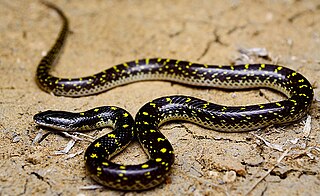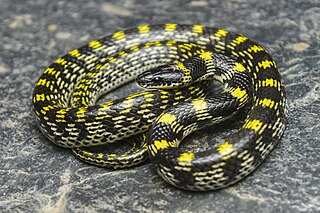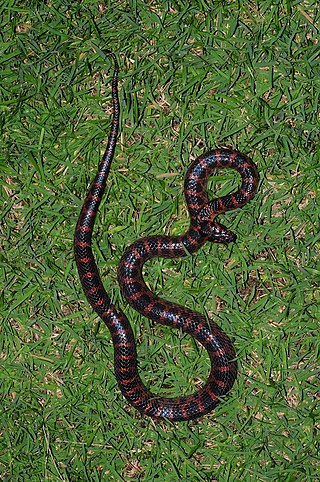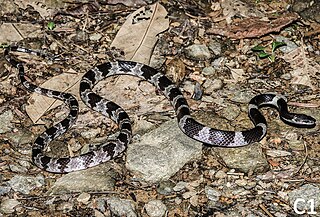
Lycodon gammiei, commonly known as Gammie's wolf snake or the Sikkim false wolf snake, is a species of nonvenomous snake in the family Colubridae. The species is endemic to India.

The white-banded wolf snake, also known as the northern large-toothed snake, is a species of colubrid snake found in Asia.

Lycodon aulicus, commonly known as the Indian wolf snake or common wolf snake, is a species of nonvenomous snake found in South Asia and Southeast Asia. Early naturalists have suggested its resemblance to the venomous common krait as an instance of Batesian mimicry.

Lycodon striatus, commonly known as the northern wolf snake or the barred wolf snake, is a species of nonvenomous colubrid snake from southern Asia.

Lycodon flavomaculatus, commonly called the yellow-spotted wolf snake, is a species of colubrid snake found in the Western Ghats of India.

Lycodon laoensis, commonly known as the Laotian wolf snake, is a species of non-venomous colubrid snake endemic to Asia.

Lycodon bicolor, commonly known as the Two-coloured wolf snake, Bicolored wolf snake, or the Golden wolf snake, is a species of snake in the family Colubridae. The species is endemic to Western Himalaya.

Lycodon is a genus of colubrid snakes, commonly known as wolf snakes. The Neo-Latin name Lycodon is derived from the Greek words λύκος (lykos) meaning wolf and οδόν (odon) meaning tooth, and refers to the fang-like anterior maxillary and mandibular teeth. They are nonvenomous, but many members of this genus strongly resemble the venomous kraits in appearance, an example of Emsleyan mimicry.

Calamaria is a large genus of dwarf burrowing snakes of the family Colubridae. The genus contains 66 recognized species. The genus is endemic to Asia.

Cyclocorus is a genus of cyclocorid snakes endemic to the Philippines. They are found on every major island except for those of the Palawan chain.

Lycodon rufozonatus is a species of snake in the family Colubridae. The species is native to East Asia. It is medium-sized, nocturnal, and is considered non-venomous. Two subspecies are recognised: one of which, L. r. walli, is restricted to the Ryukyu Archipelago; the other, L. r. rufozonatus(Cantor 1842), is found in only in Korea & China.
Lycodon bibonius, also known as Ota's wolf snake, is a species of colubrid snake found on the islands of Camiguin Norte and Babuyan Claro in the Philippines.
Lycodon chrysoprateros, also known as Ross's wolf snake, is a species of colubrid snake found on the island of Dalupiri in the Philippines.
Lycodon solivagus, also known as the common wolf snake, is a species of colubrid snake found on Luzon Island in the Philippines.
Lycodon butleri, also known commonly as Butler's wolf snake, is a species of snake in the family Colubridae. The species is native to southern Thailand and peninsular Malaysia.
Lycodon cardamomensis, also known as the Cardamom Mountains wolf snake, is a species of nonvenomous colubrid snake found in south-western Cambodia and eastern Thailand.
Lycodon cavernicolus, also known as Gua Wang Burma wolf snake, is a species of colubrid snake found in peninsular Malaysia. It was first described in 2014.

Lycodon ruhstrati, also known as Ruhstrat's wolf snake, the mountain wolf snake, or the Formosa wolf snake, is a species of non-venomous colubrid snake found in Taiwan, southern and eastern China, and northern Vietnam.
Calamaria alcalai, Alcala's reed snake, is a species of snake in the family, Colubridae. It is endemic to Mindoro, the Philippines.

Lycodon cathaya, the Huaping wolf snake, is a species of snake in the family Colubridae. It is a slender species with a total length of 562.5–910.6 cm (221.5–358.5 in), a snout–vent length of 451.4–730.1 cm (177.7–287.4 in), and tail length of 111.1–180.5 cm (43.7–71.1 in). The upper side of the head is brownish-black with a grey-tinged rose collar band, while the underside of the head is mostly whitish. The upper side of the body is brownish-black with grey-tinged rose bands that divide the brownish-black ground colour into elliptical patches. The middle of the underside has irregular brownish-black splotches making an unbroken strip along the underside with two greyish-white lines along its sides. The Huaping wolf snake can be distinguished from other wolf snakes by a combination of its scalation and coloration.













